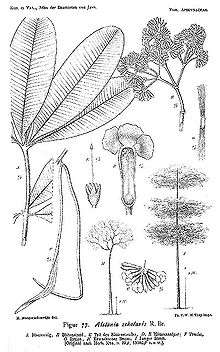Alstonia scholaris
| Alstonia scholaris | |
|---|---|
 | |
| Devil tree (Alstonia scholaris) | |
| Scientific classification | |
| Kingdom: | Plantae |
| (unranked): | Angiosperms |
| (unranked): | Eudicots |
| (unranked): | Asterids |
| Order: | Gentianales |
| Family: | Apocynaceae |
| Tribe: | Plumeriae |
| Subtribe: | Alstoniinae |
| Genus: | Alstonia |
| Species: | A. scholaris |
| Binomial name | |
| Alstonia scholaris (L.) R.Br. | |
| Synonyms[2] | |
| |
Alstonia scholaris (commonly called blackboard tree, devil tree, ditabark, milkwood-pine, white cheesewood[2]) is an evergreen tropical tree in the family Apocynaceae. It is native to the Indian subcontinent, Indomalaya, Malesia, and Australasia.
Description
_leaves_%26_flowers_in_Kolkata_W_IMG_0534.jpg)
The Alstonia scholaris is a glabrous tree and grows up to 40 m (130 ft) tall. Its mature bark is grayish and its young branches are copiously marked with lenticels.
The upper side of the leaves are glossy, while the underside is greyish.[3] Leaves occur in whorls of three to ten; petioles are 1–3 cm (0.39–1.18 in); the leathery leaves are narrowly obovate to very narrowly spathulate, base cuneate, apex usually rounded; lateral veins occur in 25 to 50 pairs, at 80-90° to midvein. Cymes are dense and pubescent; peduncle is 4–7 cm (1.6–2.8 in) long. Pedicels are usually as long as or shorter than calyx. The corolla is white and tube-like, 6–10 mm (0.24–0.39 in); lobes are broadly ovate or broadly obovate, 2–4.5 mm (0.079–0.177 in), overlapping to the left. The ovaries are distinct and pubescent. The follicles are distinct and linear.
Flowers bloom in the month October. The flowers are very fragrant similar to the flower of Cestrum nocturnum.
Seeds of A. scholaris are oblong, with ciliated margins, and ends with tufts of hairs 1.5–2 cm (0.59–0.79 in).[4] The bark is almost odorless and very bitter, with abundant bitter and milky sap.
Range
Alstonia scholaris is native to the following regions:[2]
- China: Guangxi (s.w.), Yunnan (s.)
- Indian subcontinent: India; Nepal; Sri Lanka; Pakistan; Bangladesh
- Southeast Asia: Cambodia; Myanmar; Thailand; Vietnam, Indonesia; Malaysia;[5] Papua New Guinea; Philippines
- Australia: Queensland
It has also been naturalized in several other tropical and subtropical climates.
Alstonia scholaris (Saptaparni in Bengali) is declared as the State Tree of West Bengal, India.
Uses
The wood of Alstonia scholaris has been recommended for the manufacture of pencils, as it is suitable in nature and the tree grows rapidly and is easy to cultivate.[6] In Sri Lanka its light wood is used for coffins. In Borneo the wood close to the root is very light and of white color, and is used for net floats, household utensils, trenchers, corks, etc.[7] In Theravada Buddhism, Bodhi by first Lord Buddha is said to have used Alstonia scholaris as the tree for achieving enlightenment.
At one time, a decoction of the leaves were used for beriberi.[3]
Chemistry
The bark contains the alkaloids ditamine, echitenine, echitamine and strictamine.



References
- ↑ World Conservation Monitoring Centre (1998). "Alstonia scholaris". IUCN Red List of Threatened Species. Version 2013.1. International Union for Conservation of Nature. Retrieved 19 November 2013.
- 1 2 3 John H. Wiersema. "Alstonia scholaris (L.) R. Br.". Ars-grin.gov. Retrieved 2012-03-30.
- 1 2 http://www.stuartxchange.org/Dita.html retrieved on 29 June 2007
- ↑ http://www.efloras.org/florataxon.aspx?flora_id=2&taxon_id=200018323 retrieved on 29 June 2007
- ↑ Simon Gardner, Pindar Sidisunthorn and Lai Ee May, 2011. Heritage Trees of Penang. Penang: Areca Books. ISBN 978-967-57190-6-6
- ↑ Tonanont, N. Wood used in pencil making. Vanasarn 1974 Vol. 32 No. 3 pp. 225-227
- ↑ "retrieved on 29 June 2007". Botanical.com. Retrieved 2012-03-30.
| Wikimedia Commons has media related to Alstonia scholaris. |
